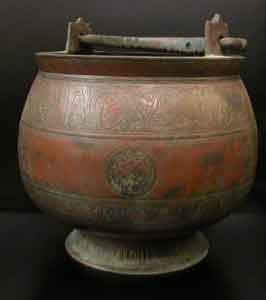Engraved Bronze Alloy Bucket, 11th Century CE - 13th Century CE
Quarternary Bronze
LO.925
In the 9th century, hordes of nomadic Turkic horseman living on the outskirts of the Muslim world began to migrate westward into the heart of Central Asia. By the 10...
In the 9th century, hordes of nomadic Turkic horseman living on the outskirts of the Muslim world began to migrate westward into the heart of Central Asia. By the 10 century, a branch known as the House of Seljuk had broken off from the Oghuz confederation of Turkomen tribesmen, arrived into mainland Persia, and settled in the province of Khurasan. Overtime, the Seljuks converted to Islam and began to adopt the Persian language and culture. In the 11th century, the Seljuks set up an independent state under their leader Tugrul Bey with its capital in Isfahan, initially under the auspices of the Abbasid Caliph in Baghdad. The arts thrived during the Seljuk period as the Turkic rulers patronized Persian culture, arts, and literature.
However, as the Arab caliph began to disintegrate, the Seljuks seized the opportunity to expand their empire westward to the Levant and Anatolia where they frequently came into direct conflict with the Byzantines. In the famous Battle of Manzikert, the Seljuks dealt the Byzantines a decisive defeat, capturing Emperor Diogenes himself, paving the way for Turkic expansion into Anatolia and the signaling the decline of the mighty Byzantines. This golden era did not last long though, as increasing waves of clans migrating from the east, pushed westward by the Mongol onslaught, coupled with Crusader armies arriving from the European west, started to destabilize the empire.
The Great Seljuk Empire was reduced to a series of smaller principalities based in Anatolia, the most prominent and powerful of which was the Sultanate of Rum. The arrival of the Mongols themselves on the Anatolian plateau in the 13th century marked the end of Seljuk independence as they were forced to become vassals to the Mongols. Despite efforts to maintain the authority of the Sultan in the face of Mongol retreat, the Seljuks completely disintegrated as a political force in the first decade of the 14th century, leaving behind numerous small mini-states most of which remain obscure, except that one led by Osman I known as the Ottomans.
Large spherical bucket with ornate handle, the surface angraved with three horizontal registers, the middle one with round medallions filled with arabesque patterns, the one above with a long inscription in ornate style, the one below inscribed in cursive script. The splayed foot incised with a further band of vertical fluted lines.
Metal buckets occured in pre-Islamic cultures in the Middle East and it is likely that the Islamic versions were based on the classical prototype of tapering cylindrical form known to have been produced in Egypt. In Persia, the flat bottomed cylindrical form gave way to a round bottomed one and then to a bucket with a round body, to which a foot was added, like the one here illustrated, common during the 12th and 13th centuries. Although in the past it has been suggested that such vessels should have ben used for carrying hot water in bath-houses, the nature of the material (bronze) and its elaborate decoration and inlays would seem to indicate a use as an ablutions 'basin'.
For a comparable example see: Hayward Gallery, The Arts of Islam, 1976: no.179, p. 170.
However, as the Arab caliph began to disintegrate, the Seljuks seized the opportunity to expand their empire westward to the Levant and Anatolia where they frequently came into direct conflict with the Byzantines. In the famous Battle of Manzikert, the Seljuks dealt the Byzantines a decisive defeat, capturing Emperor Diogenes himself, paving the way for Turkic expansion into Anatolia and the signaling the decline of the mighty Byzantines. This golden era did not last long though, as increasing waves of clans migrating from the east, pushed westward by the Mongol onslaught, coupled with Crusader armies arriving from the European west, started to destabilize the empire.
The Great Seljuk Empire was reduced to a series of smaller principalities based in Anatolia, the most prominent and powerful of which was the Sultanate of Rum. The arrival of the Mongols themselves on the Anatolian plateau in the 13th century marked the end of Seljuk independence as they were forced to become vassals to the Mongols. Despite efforts to maintain the authority of the Sultan in the face of Mongol retreat, the Seljuks completely disintegrated as a political force in the first decade of the 14th century, leaving behind numerous small mini-states most of which remain obscure, except that one led by Osman I known as the Ottomans.
Large spherical bucket with ornate handle, the surface angraved with three horizontal registers, the middle one with round medallions filled with arabesque patterns, the one above with a long inscription in ornate style, the one below inscribed in cursive script. The splayed foot incised with a further band of vertical fluted lines.
Metal buckets occured in pre-Islamic cultures in the Middle East and it is likely that the Islamic versions were based on the classical prototype of tapering cylindrical form known to have been produced in Egypt. In Persia, the flat bottomed cylindrical form gave way to a round bottomed one and then to a bucket with a round body, to which a foot was added, like the one here illustrated, common during the 12th and 13th centuries. Although in the past it has been suggested that such vessels should have ben used for carrying hot water in bath-houses, the nature of the material (bronze) and its elaborate decoration and inlays would seem to indicate a use as an ablutions 'basin'.
For a comparable example see: Hayward Gallery, The Arts of Islam, 1976: no.179, p. 170.
